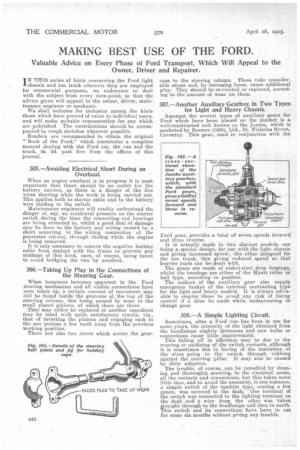MAKING BEST USE OF THE FORD.
Page 26

If you've noticed an error in this article please click here to report it so we can fix it.
Valuable Advice on Every Phase of Ford Transport, Which Will Appeal to the Owner, Driver and Repairer.
T N THIS series of hints concerning the Ford light chassis and ton truck wherever they are employed for commercial purposes, we endeavour to deal with the subject from every view-point, so that the advice given will appeal to the owner, driver, Maintenance engineer or mechanic.
We shall welcome for inclusion among the hints those which have proved of value to individual users, and will make suitable remuneration for any which are published. The contributions should be accompanied by rough sketches wherever possible.
Readers are recommended to obtain the original "Book of the Ford," which constitutes a complete manual dealing with the Ford car, the van and the truck, 2s. 0d. post free from the offices of this journal.
305.—Avoiding Electrical Short During an Overhaul.
When an engine overhaul is in progress it is most important that there should be no outlet for the battery current, as there is a danger of the live wires shorting while the work is being carried out. This applies both to starter cable and to the battery wire leading to the switch.
Maintenance engineers will readily understand the danger of, say, an accidental pressure on the starter switch during the time the connecting rod bearings are being attended to, whilst a good deal of damage may be done to the battery and wiring caused by a short occurring in the wiring connection of the generator cut-out, through chafing while the engine is being removed.
It is only necessary to remove the negative battery cable from dontact with the frame to prevent any mishaps of this kind, care, of course, being taken to avoid bridging the two by accident.
306.—Taking Up Play in the Connections of the Steering Gear.
When looseness becomes apparent in the Ford steering mechanism and all visible connections have aeen taken up, a certain summit of movement may till be found inside the searcase at the top of the steering column, this being caused by wear in the small planet pinions, of which there are three.
They may either be replaced or another expedient may be tried with quite satisfactory results, viz., that of inverting the pinions and engaging each in. the sun pinions a few teeth away from the previous working position.
There are also two rivets which secure the gear case to the steering column. These take considerable stress and, by becoming loose, cause additional play. They should be re-riveted or replaced, according to the amount of wear on them.
307.—Another Auxiliary Gearbox in Two Types for Light and Heavy Chassis.
Amongst the several types of auxiliary gears for Ford which have been placed on the .market is a well-constructed unit known as the Jumbo, which is marketed by Bra,nico (1920), Ltd., St. Nicholas Street, Coventry. This gear, used in conjunction with the
Ford gear, provides a total of seven speeds forward and three reverse.
It is actually made in two distinct models, one being a special design, for use with the light chassis and giving increased speed ; •the other designed for the ton truck, this giving reduced speed so that heavier loads can be 'dealt with.
The gears are made of nickel-steel drop forgings, whilst the bearings are either of the Hyatt roller or ball type, according to position. The makers of the auxiliary gear also supply emergency brakes of the external contracting type for the light and heavy models. It is always advisable to employ these to avoid any risk of losing control if a miss be made while endeavouring to change gear.
308.—A Simple Lighting Circuit.
Sometimes, after a Ford van has been in use for some years, the intensity of -the light obtained from the headlamps slightly decreases and new bulbs or connections cause little improvement.
This falling off in efficiency may be due to the wearing or oxidizing of the switch contacts, although it is sometimes due to baring of the insulation of the wires going to the switch through rubbing against the steering pillar. It may also be caused by dirty adapters.
The trouble, of course, can be remedied by cleaning and thoroughly securing, in the electrical sense, all the contacts and connections, but this takes some little time, and to avoid the necessitY, in one instance, a simple switch of the tumbler type, costing a few pence, was screwed to the dash. One terminal of the switch was connected to the lighting terminal on the dash and a wire from the other was taken eiraight through to the headlamps and then to earth. This switch and its connections have been in use for some six months without giving any trouble.
































